
Sometimes, we have to go back a really long way to research some of our articles and, occasionally, these glances into the rear view mirror are so distant that it seems less like research, but more like archaeology! This next research feature took us so far back that it almost felt like studying the very ancient historical roots of motor cycling itself, back to the early veteran days of what came and went, long, long ago. Today we’ll be splitting rocks from an age even before the autocycle, to find some lost record of the past—but this time the team has dug up a real Living Fossil!
This subject probably doesn’t quite fall within our normal remit, since the engine capacity somewhat exceeds our usual under-100cc guideline, but the design so obviously relates to an autocycle that we feel we can overlook such a minor technicality for the sake of so much interest.
This machine could seem particularly important as a missing link to the earliest autocycles, which it pre-dates by some 15 years...
History introduces an unlikely start to our story under the reign of Queen Victoria in 1890, when William Hobart Bird of Glenthorpe Villa, Crompton Road, Wolverhampton, submits an amended patent application for ‘An improved method for attaching lock knobs, door knobs and the like to spindles’. In 1892 an advert appears for ‘Hobart’ Cycles, illustrating a new ‘safety’ bicycle made by Hobart Bird & Co. of Victoria Cycle Works, Wolverhampton. In May of 1896 the business was still being listed at Wolverhampton but, by 1897, had relocated to St Patricks Road, Cheylesmore, Coventry, and further adverts in April 1899 for the ‘Hobart Perfect Bicycle with Bowden Brake’ now represent the business as a limited company.
In 1901 and still in the reign of Queen Victoria, as well as continuing with bicycle production, the Hobart Company started making its first primitive motor cycle with an inclined engine. By 1903 the Hobart Motor Cycle had developed to a loop frame with braced front fork and a vertical cylinder engine offered in three sizes of 2½, 2¾, and 3hp, which continued with little further change up to 1905, when the model was discontinued.
As well as producing their own machines, since 1901 Hobart had also become producers and suppliers of parts and equipment to many other companies. This side of the business increased to such a degree that, from 1906, the company aligned to manufacturing in preference to its own sales brand, until 1910 returned a new 2½hp Hobart motorcycle with Druid forks, inclined cylinder, gear-driven Bosch magneto and an adjustable pulley for the belt drive.
1911 followed with a new 3½hp twin, and a ladies’ model with revised open frame and lower mounted engine with horizontal cylinder ... all working parts fully enclosed since we don’t want the memsahib being sucked into the machinery by her dress!
By 1913 Hobart began using JAP proprietary engines as well as their own, then a 269cc Villiers motor in 1915, and a 6hp V-twin JAP with three-speed gears.
Before the First World War, Hobart had grown and developed into a big Coventry based factory manufacturing its own bicycles, motor cycles and engines, which also supplied engines, frames, and other parts to various bicycle and motor cycle assemblers.
The business returned after The Great War as Messrs Barbary and Downes assumed management of the Hobart Cycle Company in 1918 (so it appeared its founder had now left the scene), and resumed production of bicycles, two-stroke engines, a two-stroke motor cycle, and introduced a new sprung motor cycle frame. A 292cc JAP four-stroke model was presented in 1920, and more versions of both types added in 1921, including rigid and sprung frame versions for all models.
Now, about this point, blundering into our story like some old-time superhero in Harris Tweed and top hat comes George H McKenzie, a man on a self-appointed mission to bring cheap motor cycling to the British masses in the same manner as Henry T Ford did with the motor car in America. Now McKenzie had an idea and concept for a new ultra-lightweight motor cycle, though the frame arrangement seemed remarkably similar (nay, identical), to a first war Humber ladies’ step-through design, though this was probably purely circumstantial and hopefully no one would know about that anyway.
The plan was to sell his machines through franchised cycle shops, and McKenzie contracted Hobart to completely build these vehicles for him, utilising Hobart 170cc engines.
George McKenzie seemed to present himself from a number of addresses, and appears to pop up all over the place, giving addresses at 26 Warwick Row, Coventry; Lower Ford Street, Coventry; McKenzie motor cycles from Geo. McKenzie (London) Ltd, Dept 11, 220 Shaftsbury Avenue, London WC2; and also Sanderstead Works at South Croydon (which will become more significant later on).
The new pedal-assisted McKenzie Popular Lightweight models from 1921 are particularly distinguished by their lady’s-style fully open frame, and fairly resemble the appearance of early generation autocycles which would be destined to become commonplace transport some two decades later.
Now the next bit is where our archaeologist, Indiana Bones, strikes a large boulder along a likely looking sedimentary cleft line with his pairing hammer, which instantly splits the rock into two halves, and it falls apart to reveal ... a cavity on one side, and a perfect fossilised motor cycle on the other!
Let’s further examine our ancient find and see what we may glean from its analysis...
In an age of various long-stroke engines, this motor was relatively unusual for its time, being 60mm square, bore × stroke, giving 170cc, and being of deflector-top design with cast iron piston fitted with three compression rings in two grooves, two rings together in the top groove, and a single ring in the groove below.
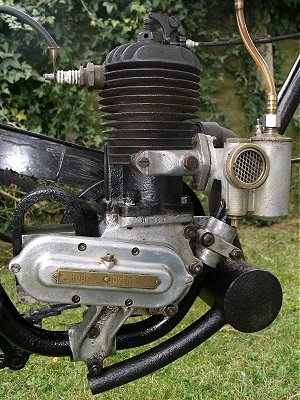
The lower motor has a two-part crankshaft driving a large external flywheel with integral belt pulley to the left, which directly drives the rear wheel by a segmented leather belt. The right hand flywheel is slotted to engage with flats on the crank-pin, and takes off its drive by a three-gear train to operate a ‘Baby Fellows’ horseshoe magneto mounted behind the engine.
Motor bearings are all plain bronze bushes for small end, big end and both main journals, so maintaining a significant oil/fuel ratio is important, and don’t expect this engine to be running much in the way of high revs.
Reference material gives the McKenzie’s all-up weight as just 80 pounds (36 kilogrammes) which would seem very light construction for a machine of this capacity, so we drag out the scales 2 stone 4 pound front + 3 stone 7 pound rear = 81 pounds, so yes, that’s right, despite holding half a tank of fuel, a heavier gauge reproduction belt guard, the addition of an improvised rear carrier and modern rear cycle stand for practical parking.
Wheels & tyres are the good old fashioned Dunlop 26 × 1¾ Carrier grade, as commonly used on trade carrier cycles, and destined to become adopted as standard fare on first-generation autocycles some 15 years from now.
The left-hand control lever that looks like a rear brake actually operates the engine decompresser. The rear hub has an inbuilt bronze-cone, back-pedal brake of sorts but, trying it out, we note it can sometimes take several back rotations to engage the mechanism, and seems fairly ineffective when it finally comes on. Never mind, there’s always the front brake operated by the right-hand control lever, through a cable to ... argh! a simple cycle stirrup with blocks acting on the front rim; so we won’t be expecting much of that either!
Basically, we expect that this is going to be a ‘no effective brakes’ test run.
The front stirrup brake only proves capable enough for just about holding the front wheel to try and demonstrate the ‘wobbly fork’ front suspension operation, but the mechanism doesn’t work by rocking the bike backwards and forwards; you actually need to push and pull the handlebars up and down to watch the pivot acting about the bottom yoke, while the wheelbase foreshortens and extends—all more worrying stuff...
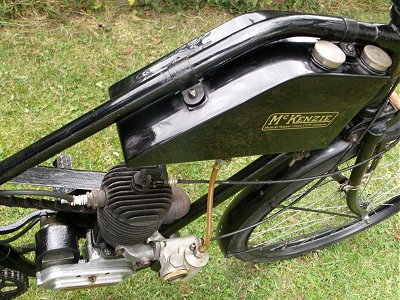
The petrol tank seems odd, in that it has two filler caps? The rear cap is obviously for fuel premix, since a tap in this section feeds to the carburettor. The partitioned forward section of the tank also has a tap, but seemingly going nowhere? Unscrew the forward tank cap, and it has an oil measure on the bottom, which you can fill from the front tap—it’s a built-in reservoir for your pre-mix oil!
The carburettor is a Wex lightweight with horizontal slide operation, and flood button to the float chamber for starting enrichment since there is no strangler choke mechanism.
The Wex air slide is worked by a throttle lever, which needs cranking pretty much right round its complete arc to fully open the valve, so opening up the McKenzie up is really going to be giving it ‘the big one’.
And that’s it for the controls; no clutch, no gears, and direct belt drive, nice and simple ... well, simple anyway...
The pedal sprockets and chain are seriously heavy gauge 1/2" × 3/16" drive chain, which may be slightly worrying since it suggests this is a machine that might be requiring some seriously heavy pedalling...
Starting would seem fairly straightforward, turn on the fuel, flood the carburetter, pull on the decompresser lever, pedal up the road, drop the decompresser, keep pedalling ... twiddle the throttle ... keep pedalling ... twiddle the throttle some more ... keep pedalling ... Bim! ... keep pedalling ... twiddle the throttle ... keep pedalling ... Bim! ... keep pedalling ... twiddle the throttle ... keep pedalling ... collapse in a heap.
Pedalling over a 170cc motor is certainly quite a bit harder work than an autocycle. These old-timer veteran riders must have been made of pretty stern stuff to use things like this for transport. We just don’t appreciate how easy things have become these days.
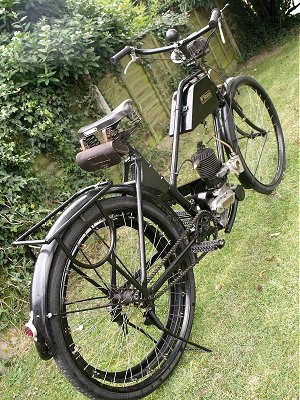
Well, after a gasping recovery, we cleaned the spark plug, tried flooding the carburetter several times, and pedalled the reluctant brute several hundred yards up and down the road, trying different throttle settings, even achieving some successive firing episodes—but never really managed to keep the engine going long enough to convincingly say that we had it running as such.
Nope! There’s only so much of this nonsense that modern man can take and, besides, we’re not fit enough to stand much more of this without inducing a heart attack—there’s only one thing for it, we’ll have to resort to the electric starter!
Oh, didn’t you know that the McKenzie had an electric starter?
Well, it’s called a mains electric drill with a flank drive socket on the flywheel nut!
On the stand, decompresser in, power the motor over, drop the lever, keep the power on while twiddling with the throttle ... Bim ... Bim ... Bim ... Bim ... Blahhhhh, and just keep the power on until the motor finally takes over—beats the exertion of pedalling every time!
We run the engine until the cylinder gets a good bit of heat up and responds reasonably to throttle. Then decompress the motor to a stop so we can take it off the stand and kit-up for our test run while the engine is pre-heated—and hopefully, it’ll restart when we pedal it off this time.
Direct drive may be simple, but certainly comes with its own complications!
Walk the bike over to the track with the decompresser on, mount up, pedal away, drop the decompresser and success, the still-hot motor fires right up and we’re away with the pace bike tracking our course.
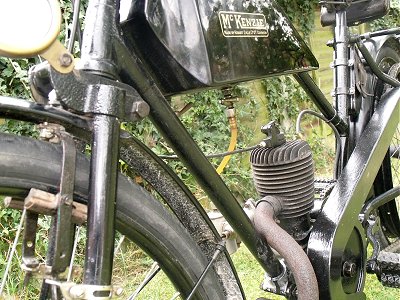
The Hobart engine responds quite well to throttle from the low range, and readily pulls us up to a steady chuffing cruising speed of 21mph. This seems a fairly settled and happy pace for the motor, which is not too busy, and doesn’t generate too many vibrations, rather suggesting it’s reasonably comfortable at this rate. Handling of the cycle, however, is much more of an issue at this stage: it’s a wobbly and rattling experience where the whippy cycle frame doesn’t convince that it’s rigid enough for the job, while the back end feels like it might be crabbing down the road. The wobbly suspension forks give a somewhat ‘random’ sensation as to where the bike might be going, while the pull-back handlebars shudder and shake to make you wonder quite who’s actually controlling what? Steering feels a rather vague affair and really makes you appreciate how motor cycling technology has significantly advanced over the intervening 90 years!
Turning onto the main straight now presents an opportunity to sample the effects of more throttle, so wind open the control lever and heavy vibrations come piling straight in through the pedals. Despite the 170cc capacity, there’s not really any effective surge of power from opening the throttle wide, more just a surge of vibration and louder noise from the exhaust while the bike tries to lumber along a little faster, as the pilot tries to keep his nerve and coax the reluctant contraption away from diving into the hedgerow!
This particular test track on a private farming estate is not quite made up to the standard of the public highway, though it might reasonably represent a typical road of the 1920s period; riding McKenzie under these conditions would probably be quite challenging enough for most riders today.
In the meantime, our pace bike was maintaining a precautionary safe distance from the menacing and unstable McKenzie ahead, blundering along the roadway, rattling, wobbling, clattering, and belching out clouds of smoke in its anger.
Best on flat tipped at 28mph, and that was sitting firmly upright since no sane person would want to even consider adopting a crouch position on one of these old things along far less-than-perfect road conditions.
We were quite happy to have seen 28 in a short burst, since that was exactly the same maximum speed reported in a 1923 road test and, though we had a feeling that the bike might be encouraged to run a little faster under more ideal conditions and using modern fuel, it’s really not something we’d be too happy trying from a 90-year-old motor with all plain bearings. Such old type two-stroke engines don’t much like higher revs, or the generated heat and stresses associated with running up to speed, and usually need to have built up a goodly presence of internal oil to deliver just occasional attempts, so it’s not at all the same game as nailing a modern two-stroke.
Easing down at the end of the strip, it wasn’t really possible to keep the engine running slowly enough to complete a low speed turn in the road, so we decompressed the motor to a stop to turn for the return leg—but would the old Mac restart?
Pedal away again on the decompresser, drop the valve, and it fires up straight away—shame on us for even having a doubt!
Mission accomplished, we were happy to just chuff back at a steady pace, and the pace bike even mustered enough confidence to ease up alongside to report we’d naturally settled to cruising at exactly 21mph again.
Exhaust tone from the can silencer is neither smooth nor quiet, and sounds everything it is—an old motorbike!
Headlamp lighting is ... well, not something you’d relate to in any modern sense ... the Baby Fellows magneto only provides ignition sparks, there is no electrical generator on the Hobart engine ... it’s acetylene lighting, so you need carbide, water and matches.
If you’ve never played with ancient carbide lamps before, they can produce quite a powerful white light, though this tends to be rather scattered as there often isn’t much in the way of beam direction. The lamps also require a fair bit of maintenance and forward planning in terms of having the essential materials for when you want to use them. It’s certainly nothing as simple as flicking a switch.
As expected, the brakes were practically useless, there was almost no point in bothering with them at all, just plan well ahead, slow down on the throttle, pace your manoeuvres and stop on the decompresser if you absolutely have to. We did try out effectiveness of the back pedal brake, but the hub seemed completely unable to engage any braking operation once in motion, and only appeared to function when the bike was at a standstill—lot of use that is!
At Hobart in 1923, their 269cc Villiers model was replaced by a new motor cycle with the 170cc Hobart engine driving a 2-speed gearbox, and the 292cc JAP motor replaced by a 249cc side-valve Blackburne. All the four-stroke models were offered with a range of transmission options in two & three-speeds, and choice of belt or chain for final drive. The McKenzie open style frame seems to have suffered some weakness issues, since it became redesigned with a lowered engine and strengthened with an additional horizontal strut for 1923. By this time, Hobart had begun offering their own branded Universal light motor cycle model for just £21, and effectively identical to the McKenzie, which was still being listed for 26 guineas.
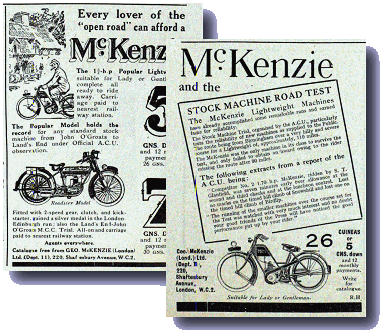
Nor did George McKenzie seem to waste much time in adopting the latest gearbox and frame developments of Hobart’s 170cc motor cycle, since he was shortly presenting a counter-shaft clutch kit for £5–15s and two-speed gearbox for £7–15s offered as extras with a chain primary drive and final drive belt to the rear wheel as before.
These components also appear to have been common to a new McKenzie Roadster Model lightweight motor cycle, now fitting the 170cc Hobart engine in a conventional frame with a large round fuel tank, kick-starting, clutch and two-speed gears, and described by Motor Cycle magazine in October 1923 as a ‘thoroughly practical miniature’.
All seemed to have gone fairly well up to this point, but now everything started to unravel!
Later in the year Hobart was taken over by Rex–Acme, also of Coventry, to become Hobart–Acme Motors.
Messrs Barbary and Downes left Hobart and went on to re-establish business at Wellington Street, Coventry, as Coventry Bicycles Ltd. They very shortly began producing motor cycles branded as Coventry B&D, ‘Wee MacGregor’ & ‘Wee Mac’ branded lightweights, and employing the 170cc Hobart engine, though using a conventional motor cycle frame.
George McKenzie’s contract with Hobart and his plans for the 1924 season were presumably casualties of the Rex–Acme takeover; since there is little evidence that any production examples of the McKenzie Roadster Model lightweight motor cycle were actually built.
In 1924 the Hobart-branded motor cycle range was reduced to the 170cc two-stroke, and 292cc and 346cc JAP engine four-stroke models. It was the final year of listing and Hobart motor cycles were discontinued, though Hobart engines continued to be supplied to other companies for several more years.
With the Rex–Acme buy-out seemingly compromising his production contract with Hobart, George McKenzie’s intentions for the coming year became desperately revised in a plan to resume sales with a completely new McKenzie motor cycle by arranging a new manufacturing contract with Grigg (1924) Ltd. of Winchester Works, Twickenham. The plan was for Grigg to build up to 50 machines per week using a JAP-manufactured Aza 147cc two-stroke engine, Albion two-speed gearbox with clutch, kick-starting, and chain/belt drive.
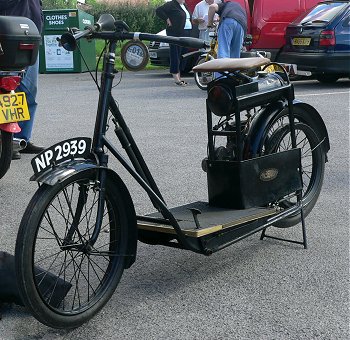
Grigg scooter
George McKenzie appears to have had some connection with the earlier Grigg Company since their previous Sanderstead Works address had been given on some of McKenzie’s business leaflets, and this association clearly pre-dated his 1924 contract with the later Grigg Ltd Company at Twickenham.
The Grigg company was initially established in 1919 at Sanderstead Works, South Croydon, Surrey to manufacture a small and basic open-framed scooter powered by a small 145cc two-stroke engine mounted to the right of the rear wheel.
In 1921, the original engine was enlarged to 162cc to produce a lightweight motor cycle with duplex tubular frame and two-speed gearbox. As the Grigg scooter had failed to create many sales, the company needed to look toward dealing in a diversified range of other products to generate additional business, including electric lighting sets, gears, sprockets and general machinery.
A three-speed version of the lightweight motor cycle was launched in 1922, while the scooter was discontinued.
A range of motor cycle models was introduced for 1923, variously fitted with small Villiers and Shaw motors, up to and including larger Blackburne and B&H (Bacher & Hellow) V-twin engines up to 1000cc. However, the machines made little impression on the established trade since there were a significant number of similar motor cycles on sale from other manufacturers in an already saturated market.
The Grigg business moved to Winchester Works, Twickenham and reformed as Grigg (1924) Ltd to take over and resume the operation by securing sole manufacturing contracts to building of Metro–Tyler light cars (up to five per week) and Metro–Tyler Cycle-cars (up to five per week), Wooler motor cycles up to 50 per week, the McKenzie contract up to 50 per week, as well as continuing Grigg’s own motor cycle range.
Due to poor sales right across the motor cycle trade, McKenzie’s ambitious plans seem to have faltered during the year, and required some review of his business with intent to secure goodwill and resume production with Grigg again for the following year.
While Grigg continued its own full range of machines in 1924, the general slump in motor cycle market sales was seriously weakening its overall business position and, while attempting to compensate by offering general machining services, it wasn’t enough, and the company had collapsed by 1925.
Considering the transfer of manufacturing contracts, presenting a new motor cycle model and the poor economic climate it seems unlikely that many Grigg-built McKenzie motor cycles were actually made and sold.
George McKenzie’s further motor cycling entrepreneurialism seemed to evaporate with the demise of Grigg, and that concluded his contributions to the sector.
There were also McKenzie light motor cars and Cycle-cars listed from 1913–1926, supplied by a Thomas McKenzie at addresses of Charles Henry Street and Bath Passage, Birmingham.
It’s possible that George McKenzie might have been a relative of Thomas McKenzie, as their common methods of presenting a dot under the ‘c’ of the surname was particularly distinctive. It could just be co-incidental that there were similarities between the McKenzie light motor cars and cycle-cars of this period, and the Metro–Tyler vehicles that were being constructed by Grigg.
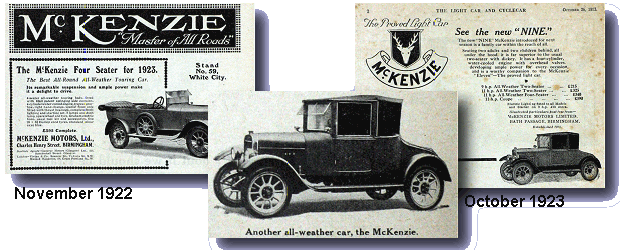
Barbary & Downes built motor cycles with their Coventry B&D badge in only limited numbers, using JAP single engines from 346–996cc V-twins, and with the 346cc Barr & Stroud sleeve-valve engine, until this brand disappeared in 1925. Later Wee MacGregor & Wee Mac lightweights were listed with a slightly larger engine above 200cc (probably some other make, as Rex–Acme withdrew the Hobart 170), but the Mac models also seem to have concluded by the end of the year.
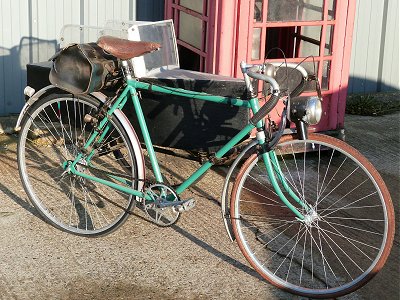
1929 Three Spires ‘Clubman’ bicycle
Barbary and Downes continued by concentrating on cycles as Coventry Bicycles Ltd, and toward the years of the Great Depression. Around 1927 B&D began using a Three Spires logo, and shortly adopted this name as one of their cycle brands. The ability of their smaller business to seemingly adjust and contract to the changing economic climate afforded an appreciable advantage compared to some larger concerns that found themselves unable to generate the level of business required to maintain liquidity through difficult times.
The last traceable reference to George McKenzie is entered around 1928, appearing at an address of Hill Cross, Coventry, after which he seems to disappear off the radar.
The times very much turned against the fortunes of Rex–Acme, whose production collapsed during early years of the Great Depression in 1931, and the name was bought out by Mills–Fulford sidecar manufacturers.
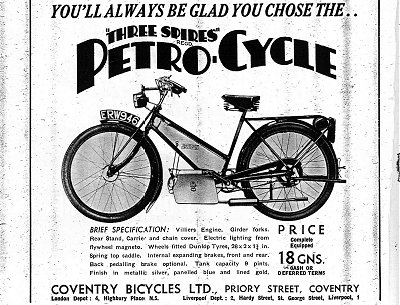
Coventry Bicycles took another brief dalliance into motor cycles in 1931, with an old-fashioned style lightweight under Three Spires branding, with 147cc Villiers engine and two-speed gearbox, but this was withdrawn in 1932, the business again continuing with cycles instead.
The Great Depression was still further taking its toll on manufacturing industry as the Mills–Fulford business collapsed in 1933.
Three Spires nearly returned with a Villiers engine autocycle in 1939, showing and advertising some models, but production failed to materialise as World War Two intervened.
Though the McKenzie Popular Lightweight was only effectively available for three years, it proved quite a popular little budget machine with the public, and sold fairly well in its brief time. While subsequently becoming largely lost and forgotten over the intervening eight decades, the McKenzie now probably deserves some recognition as a significant, important and historical ‘missing link’ towards evolution of the later British autocycle.
Next—our main feature involves emigration to the North Americas, to visit one of the greatest and most famous moped names in the world! A machine under this brand has just got to be just fantastic, hasn’t it? Though we may have our reservations ... Our Shaman says ‘When you have seen the top of the mountain, it’s just a long way back down again’, and for sure, The Fall is certainly one of the most epic tales of motor cycling misfortune.
This article appeared in the
April 2013 Iceni CAM Magazine.
 [Text © 2013 M Daniels.
Period documents from IceniCAM Information
Service. The Indiana Jones and the
Fossilised Mckenzie picture was created by Andrew Pattle for
Iceni CAM Magazine
using original photographs by Another
Believer (rock) and Mark
Daniels (motor cycle) and is licensed under a Creative
Commons Attribution–ShareAlike 3.0 Unported
License. Please contact us
for a higher resolution version. Three Spires bicycle
photograph © 2013 A Pattle. Grigg scooter
photograph © 2008 A Pattle. All other photographs
© 2013 M Daniels.]
[Text © 2013 M Daniels.
Period documents from IceniCAM Information
Service. The Indiana Jones and the
Fossilised Mckenzie picture was created by Andrew Pattle for
Iceni CAM Magazine
using original photographs by Another
Believer (rock) and Mark
Daniels (motor cycle) and is licensed under a Creative
Commons Attribution–ShareAlike 3.0 Unported
License. Please contact us
for a higher resolution version. Three Spires bicycle
photograph © 2013 A Pattle. Grigg scooter
photograph © 2008 A Pattle. All other photographs
© 2013 M Daniels.]
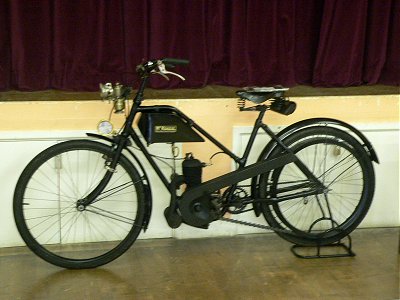
The Mckenzie on display at
the Coprolte Run back in 2008
The McKenzie Popular Lightweight had been around and available to us for a few years before we actually got round to processing it for road test and photoshoot—not for any particular reason, other than we hadn’t really been concerned about it for a feature before! It’d been presented among the display bikes at Copdock Show on our joint IceniCAM/EACC stand on at least one previous occasion but, somehow, it never actually occurred to us to consider it for an article since ... well, we just didn’t!
Our McKenzie came up for display at the Coprolite Run in 2012, and got left behind in the workshops for further exhibition at the 2012 Copdock Show in another couple of weeks time, and it wasn’t until owner Luke Booth dropped the bike off, that we wondered ... does it actually go?
A few mail exchanges confirmed that it did run ‘a little’, but needed some aspects fixing to be suitable for a proper test, so the workshops could deal with those matters easily enough and we still had loads of time to draft preparatory notes, do a photoshoot and road test.
Though the McKenzie technically fell slightly outside our usual general brief due to its 170cc capacity, it represented such an important ‘missing link’ Neanderthal pre-autocycle, that we originally thought it might justify a feature in the third ‘oddball’ feature slot, where we often tend to push the envelope a little with some strange and marginal machines. As things worked out, however, the article content expanded so much that it became promoted to lead slot.
The Mckenzie’s direct belt drive is a particularly primitive arrangement that many of today’s readers may probably have never experienced, and it’s a long way from the functional practicality of modern clutch and geared machines ... with brakes ... with lights ... with suspension that works! It does however need to be considered that the McKenzie was 90 years old at the time of our test and pre-dated the first generation English autocycles by 15 years!
There’s no question that the McKenzie classed among the smallest capacity and low-powered budget transport of its time, and its story followed a particularly interesting tale around a number of distant and now obscure manufacturers. These ancient names are probably unknown by many people now, but were pretty significant players in their day. Hobart and Rex–Acme were big companies in the early years of motor cycling, and their tales of fish and bigger fish, hard times and recession, are still familiar themes in our daily news, so some things never seem to change!
We’re very pleased we got to do the McKenzie in the end since its legendary folklore story is particularly unusual, interesting and different—a great addition to our on-building features list.
As the McKenzie went back to Hastings after the Copdock Show, Luke brought another bike straight in its place, coincidentally one of the very Peugeot vélomoteurs that preceded this publication. The previous ‘cross-channel’ edition featured a particularly French theme, so we thought it only fair that some old English machines should have their chance to reply.
The idea for Andrew’s ‘digital dabble’ picture naturally evolved from the text. The bizarre concept of the archaeological presentation of a fossilised motor cycle by the ‘Indie’ skeleton just seemed too wacko to miss, and appealed enough to result in creation of the digital montage. If such things can raise a smile, then all the effort seems worth while.
Costs to produce the McKenzie feature were practically zero since the bike was dropped and collected back by its owner, so concerned none of the usual travelling costs, though it did absorb a few hours of workshop time to fettle the machine back to functional order.
Pete Smith of Hertfordshire Section EACC scored sponsorship credit for the McKenzie, though not for any particular reason other than his name just came ‘out of the hat’.